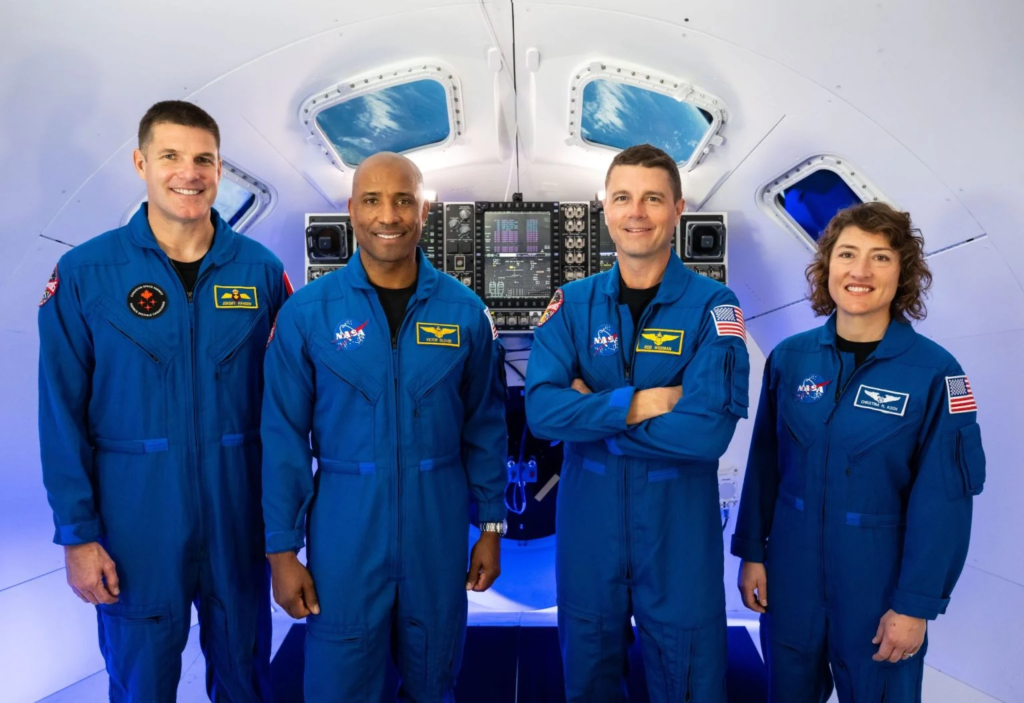|
Getting your Trinity Audio player ready...
|
Houston, Texas – In a groundbreaking announcement, NASA revealed plans for the upcoming Artemis II mission, which will mark the first human visit to the moon in over 50 years. The crew, set to embark on this historic journey in 2024, will consist of four individuals representing diverse backgrounds and breaking barriers in space exploration.
Leading the Artemis II mission will be Victor Glover, a former Navy commander and devout Christian who has worshipped with Churches of Christ in both Houston, Texas and his home state of California. With combat missions in Iraq and experience as a legislative fellow to the late U.S. Sen. John McCain, Glover joined NASA in 2013, becoming the first Black astronaut assigned to a long-duration mission when he ventured to the International Space Station in 2020.
While Glover expressed his desire to go to the moon during the previous mission, he acknowledged that it was beyond his control at the time. However, Artemis II will now fulfill that dream, solidifying his place in history as the first Black astronaut to visit the moon, although he will not be setting foot on its surface just yet.
Joining Glover on the 10-day flight test of NASA’s Orion spacecraft next November will be Commander Reid Wiseman, mission specialists Christina Hammock Koch, and Jeremy Hansen. Koch will make history as the first woman to fly a lunar mission, while Hansen will be the first Canadian astronaut to do so.
The last crewed mission to the moon, Apollo 17, took place in December 1972, over half a century ago. NASA’s Artemis II mission aims to lay the foundation for future moon landings, establish a long-term presence on the lunar surface, and eventually pave the way for crewed missions to Mars.
Expressing his gratitude and faith, Glover thanked God for the remarkable opportunity during the Artemis announcement event in Houston. He emphasized that the celebration extended beyond the four individuals’ names, urging everyone to appreciate this momentous occasion in human history.
Glover also highlighted the importance of the mission as a source of inspiration, fostering cooperation, peace, and unity not only between nations but within the United States as well. He expressed his hopes that God would bless the mission and that it would serve as a beacon of inspiration for all.
As NASA prepares for this historic endeavor, the Artemis II mission stands as a testament to the agency’s commitment to diversity, inclusivity, and the advancement of human exploration. The world eagerly awaits this significant milestone and the positive impact it will have on future space missions and the collective imagination of humanity.
The upcoming Artemis II mission not only represents a remarkable achievement in space exploration but also ignites the collective imagination of humanity. The endeavor carries the potential to inspire generations, break down barriers, and foster unity as people from diverse backgrounds come together to push the boundaries of human knowledge and exploration.
As NASA sets its sights on the moon once again, the mission serves as a testament to the agency’s commitment to inclusivity and representation. The presence of Victor Glover, the first Black astronaut assigned to a long-duration mission, Christina Hammock Koch, the first woman to fly a lunar mission, and Jeremy Hansen, the first Canadian astronaut on a lunar mission, symbolizes the progress being made toward creating a more inclusive and equitable space program.
The significance of this milestone extends far beyond national boundaries. The Artemis II mission highlights the power of international cooperation and collaboration. In an era where nations face various challenges, space exploration serves as a unifying force, bringing people together for a common purpose. The mission serves as a reminder that humanity’s greatest achievements are often realized through collective effort, transcending differences, and striving for a shared future.
NASA’s ambition to establish a long-term presence on the moon and pave the way for crewed missions to Mars reflects the indomitable spirit of exploration that has driven human progress throughout history. The moon, once a distant dream, is now within reach, and the lessons learned from Artemis II will lay the groundwork for future lunar missions, enabling humanity to unlock the secrets of our celestial neighbor and expand our understanding of the universe.
The impact of Artemis II extends beyond scientific discovery and technological advancements. It sparks the imagination of countless individuals, inspiring a new generation of scientists, engineers, and explorers. The mission serves as a beacon of hope, showcasing the boundless possibilities that lie ahead when ambition, dedication, and collaboration converge.
In a rapidly changing world, where societal, environmental, and technological challenges loom large, the Artemis II mission reminds us of the potential within humanity to overcome obstacles and reach for the stars. It prompts us to envision a future where borders are transcended, diversity is celebrated, and the pursuit of knowledge knows no bounds.
As NASA embarks on this historic journey to the moon, the world eagerly awaits the remarkable achievements, groundbreaking discoveries, and inspirational moments that will undoubtedly emerge. The Artemis II mission represents a giant leap for humanity, reminding us of our collective potential to reach new heights and explore the unknown.



